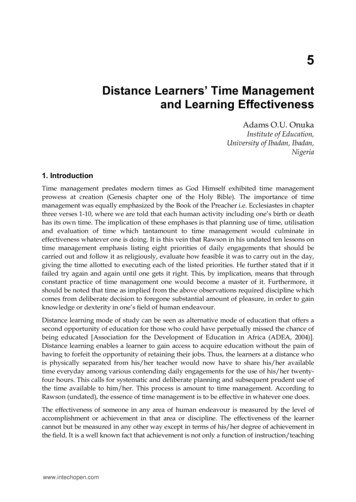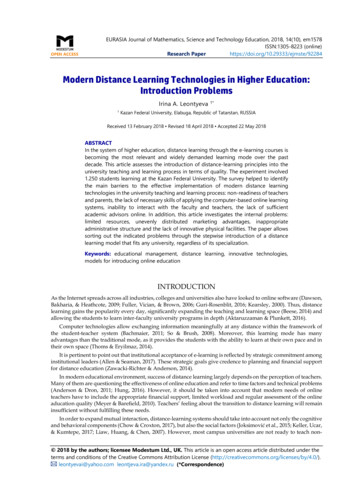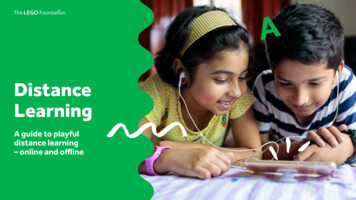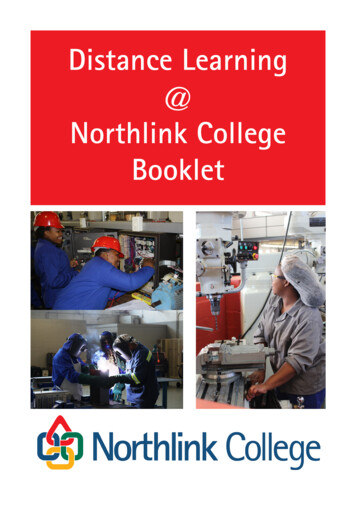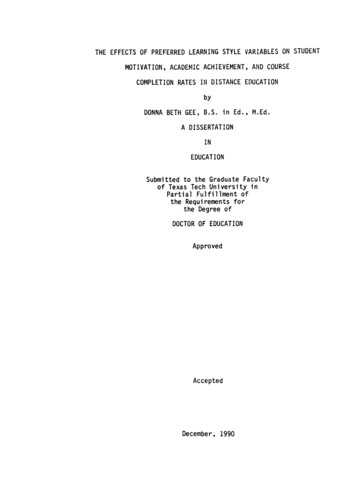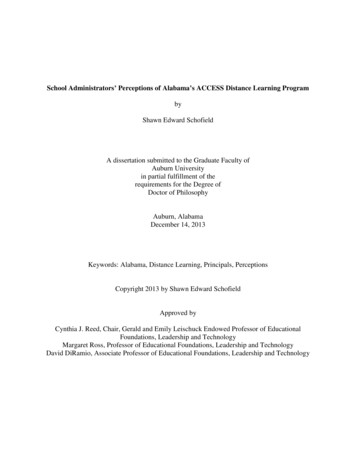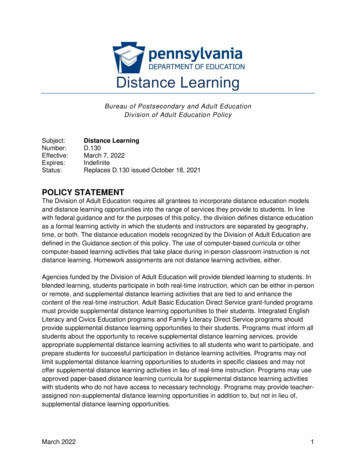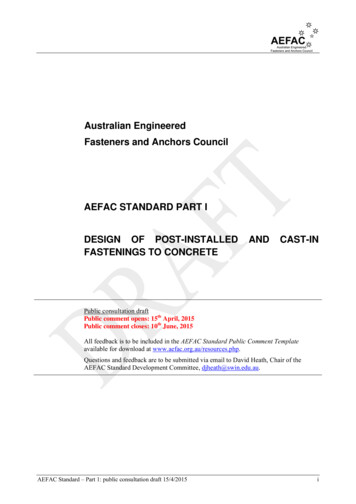
Transcription
Interdisciplinary Journal of e-Skills and Lifelong LearningVolume 11, 2015Cite as: Ramos, J. S., da Silva, L. K., Pinzan, A., Rodrigues, A. de C., & Berretin-Felix, G. (2015). Distance learning:Effectiveness of an interdisciplinary course in speech pathology and dentistry. Interdisciplinary Journal of e-Skills andLife Long Learning, 11, 101-121. Retrieved from os1633.pdfDistance Learning: Effectiveness of anInterdisciplinary Course in Speech Pathologyand DentistryJanine Santos Ramos, Letícia Korb da Silva, Arnaldo Pinzan,Antonio de Castro Rodrigues and Giédre Berretin-FelixFaculty of Dentistry of Bauru, University of São Paulo,Bauru, São Paulo, Braziljaninesramos@hotmail.com leticiakorb@usp.brarnaldopinzan@gmail.com acastro@fob.usp.br gfelix@usp.brAbstractObjective: Evaluate the effectiveness of distance learning courses for the purpose of interdisciplinary continuing education in Speech Pathology and Dentistry. Methods: The online course wasmade available on the Moodle platform. A total of 30 undergraduates participated in the study(15 from the Dentistry course and 15 from the Speech Pathology course). Their knowledge wasevaluated before and after the course, in addition to the user satisfaction by means of specificquestionnaires. The course was evaluated by 6 specialists on the following aspects: presentationand quality of the content, audio-visual quality, adequacy to the target public, and informationmade available. To compare the obtained results in the pre- and post-course questionnaires, thetest Wilcoxon was carried out, with a 5% significance level. Results: the teaching/learning process, including the theoretical/practical application for the interdisciplinary training, proved to beeffective as there was a statistically significant difference between the pre- and post- course evaluations (p 0.001), the users’ satisfaction degree was favorable and the specialists evaluated thematerial as adequate regarding the target public, the audio-visual information quality and thestrategies of content availability. Conclusion: The suggested distance-learning course proved tobe effective for the purpose of Speech Pathology and Dentistry interdisciplinary education.Keywords: Distance Learning, Speech, Language and Hearing Sciences, Dentistry, Interdisciplinary Research.IntroductionMaterial published as part of this publication, either on-line orin print, is copyrighted by the Informing Science Institute.Permission to make digital or paper copy of part or all of theseworks for personal or classroom use is granted without feeprovided that the copies are not made or distributed for profitor commercial advantage AND that copies 1) bear this noticein full and 2) give the full citation on the first page. It is permissible to abstract these works so long as credit is given. Tocopy in all other cases or to republish or to post on a server orto redistribute to lists requires specific permission and paymentof a fee. Contact Publisher@InformingScience.org to requestredistribution permission.Overview of DistanceLearningThe global improvement of the information and communication technologyis an unquestionable reality, and peoplehave more possibilities to access onlinesources every day. Based on this trend,the health field has the opportunity toEditor: Gila KurtzSubmitted: January 21, 2015; Revised: May 11 and June 30, 2015; Accepted: August 3, 2015
Distance learning: Effectiveness of an interdisciplinary course in speech pathology and dentistryincrease its benefits, mainly on continuing the education of professionals.Distance learning allows the student to study independently, according to his/her pace and spatiotemporal planning, and face-to-face meetings may occur offering opportunities for the socialization and the collaborative learning (Aretio, 2001).Reports on distance learning are found in literature in the medicine field (Gardella, Guarin, &Vive, 2003; Llambí et al., 2007; Pinto et al., 2008; VanLue et al., 2007) and, mainly, in the nursing field (Campbell, Gibson, Hall, Richards, & Callery, 2008; Edwards, 2005; Holtslander, Racine, Furniss, Burles, & Turner, 2012; Teles Filho & Cassiani, 2008; Xelegati & Evora, 2011).The quality of the service of tele-education and tele-assistance has been proved by different authors (Eskenazi, Martins, & Ferreira, 2013; Hersh, Junium, Mailhot, & Tidmarsh, 2001; Rafiq &Merrell, 2005; Roine, Ohinmaa, & Hailey, 2001; Shaikh, Lehmann, Kaleida, & Cohen, 2008;Vucković et al., 2003); however, the cost-effectiveness relation still deserves investigation (Soirefmann, Blom, Leopoldo, & Cestari, 2008).In the nursing field, Teles Filho and Cassiani (2008) developed and evaluated a module on Medication Administration offered on a web-based virtual learning environment. The researchers usedthe Engagement Theory as a theoretical and methodological approach in the study carried out intwo stages: the creation of the module and its evaluation by specialists. The instructional materialhad little amount of information on each screen and different font styles, sizes, and colors wereused to highlight the contents. It also had images to ease the understanding and make the environment more attractive. The specialists (nurses, postgraduates, and professors) evaluated the material as to the content and informatics. They evaluated the module positively regarding the content distribution and accessibility, the use of images, and the explicitness and easiness to executethe program. So, the researchers concluded the module is appropriate to be used with studentsfrom the Nursing course.Xelegati and Evora (2011) developed a virtual learning environment (VLE) for continuing training in order to manage and prevent adverse events in the nursing field. The authors used a threestage model, known as Computer Assisted Instruction (CAI), to develop the VLE. This modelconsists of exercise and practice, tutorial and simulation, as well as problem solving. The structure used for the VLE was the non-linear “interactive book” that encompasses some resourcessuch as interactions of hypertexts, videos, sounds, static images, or animations. The authors initially identified the target public, chose the theme, and defined the objectives to be addressed, theresources available, and the instructional design. Then, the course was offered in five modulesthat consisted of contents, exercises, references, and supporting texts. They concluded that thedevelopment of a virtual learning environment addressing the management of adverse events willcontribute to the awareness of nurses regarding the types of events, risk factors, classification,and incidence. However, a technical and content evaluation of the VLE is necessary to enable theuse of the material in the continuing education of nurses in health institutions.Regarding the distance learning in the medical field, Hersh, Junium, Mailhot and Tidmarsh(2001) developed and evaluated a distance learning course to be used in continuing education inmedical informatics. The course was offered in the Blackboard Course info software as it presentsa much simpler and consistent user’s interface, which was compatible with the teaching modalities the authors planned on using. In addition to the course, the authors aimed at providing students with some parallel experiences through lectures, readings, and interaction among studentsand professors. The course resources consisted of online lectures that were developed by meansof streaming audio plus slides in PowerPoint, discussion boards to promote the students interaction, and homework (multiple choice). A subject and different assignments were provided eachweek throughout the three-month course. Students were assessed by multiple-choice tests and atake-home final examination. They showed a strong satisfaction with the teaching modality,102
Ramos, Silva, Pinzan, Rodrigues, & Berretin-Felixcourse content, and system performance. The authors observed the performance of distance learning students was superior to the performance of on-campus students and concluded that thecourse on medical informatics was successfully implemented by means of distance learning technologies, had a favorable satisfaction from students, and demonstrated learning.Eskenazi, Martins, and Ferreira (2013) aimed at verifying the increase in knowledge and thecounseling skills of students in the fifth year of a graduate course in medicine regarding the practice of oral health after a course of interactive tele-education. The study assessed 148 students thatwere divided into four groups (a control group and three others) that received progressive face toface and distance learning interventions. Only one of the groups was also in touch with specialistsin oral health promotion. The knowledge increase was measured by a written test applied beforeand after the course. The authors observed the knowledge increase of the experimental groupswas statistically superior to the control group and the performance of the group that was in touchwith the specialists in oral health promotion was significantly superior to the other groups.Based on the satisfactory results observed in the pioneering studies involving distance learning inthe health field, it is relevant to consider that other areas can also benefit with this learning method. Therefore, the extension and application of distance learning courses in the other health fieldswill also contribute with the teaching and learning process.Distance Learning: Dentistry and Speech PathologyThe growth of tele-dentistry has increased in the past years (Cartes-Velasquez & Bustos-Leal,2012), and the enforcement of distance learning in Dentistry can be exemplified by MEDICOL, awebsite whose goal is to be an addition to learning (Broudo & Walsh, 2002), as well as by thedevelopment of an online atlas on Pediatric Dentistry with photos, illustrations, and x-rays, whichhas had a high level of users’ approval. There is also a report on a distance learning pilot study inperiodontics for graduate programs in European Countries. Such study used a virtual classroom,synchronous and asynchronous communication, in addition to the access to online libraries andmultimedia material (Mattheos, Nattestad, Schittek, & Attström, 2001). Since 2009, in the University of Missouri – Kansas City School of Dentistry, a faculty member teaches a hybrid onlinecourse (synchronous and asynchronous communication) with a highly specialized content in oralembryology and histology for students in dental hygiene and dentistry (Gadbury-Amyot, Singh,& Overman, 2013). Distance learning specialization, update, and extension courses in Dentistrywere found in Brazil (Masotti, Jardim, Oshima, & Pacheco, 2002; Olival, Curvino, Faria, &Groisman, 2008), as well as support material to undergraduate students (Skelton-Macedo et al.,2007).In Speech Pathology, Smythe and Hughes (2008) studied the enrolled students’ performance in anonline program/course in basic human anatomy, which included online and face to face classes.The results showed the students’ performances decreased whenever the themes were approachedonly online.In audiology, Lieberth and Martin (2005) proved the efficiency of the use of a web-based puretone audiometry simulator by Speech Pathology undergraduate and graduate students. Inglês, Rojesky, and Branham (2000) developed a distance learning course for graduate students and speechpathology professionals, which approached the training of counseling skills in audiology provision services, and noticed that, despite the limitations related to the electronic instruction, thelearning resembled that obtained in the conventional classroom. A study (Blasca, Maximino,Galdino, Campos, & Picolini, 2010) evaluated a model of interactive tele-education for audiologyteaching, and they concluded the educational material was effective in the teaching and learningprocess.103
Distance learning: Effectiveness of an interdisciplinary course in speech pathology and dentistryRegarding the knowledge on voice, the Educational CD "The Voice: speech pathology and medicine” developed along with the Virtual Man Project of the Telemedicine Discipline, Universidadede São Paulo (USP), has information about the anatomy and physiology of voice and speech production, and it has demonstrated to be effective as an auto learning instrument to speech pathology and lyric singing students (Vieira, Berretin-Felix, & Brasolotto, 2009).By means of a literature review on tele-health in speech pathology, a study (Spinardi, Blasca,Wen, & Maximino, 2009) noted the scarcity of publications aimed at distance learning as well asthe centralization in the audiology field, showing the need to develop other projects, seeking theimprovement of the services offered and the easiness to access them, generating a more effectiveimpact on prevention, diagnosis and intervention of communication disorders.There are no reports in literature about distance courses involving the interdisciplinary training orrelation among health professionals.Significance of the Study and PurposeAmong the different speech pathology specialties, there is the Orofacial Motricity, which approaches the disorders related to the stomatognathic system (Conselho Federal de Fonoaudiologia, 2006). Such alterations can be evidenced in dental cases, considering that functional abnormalities such as oral breathing, swallowing with tongue interposition, unilateral chewing, andorofacial muscle abnormal posture can be related to malocclusion (Yamaguchi & Sueishi, 2003).Since 2002, authors Jorge, Duque, Berretin-Félix, Costa, and Gomide have already suggested theimportance of the performance of an interdisciplinary team, being constituted specially by pediatric dentists and speech audiologists, in the treatment of some deleterious oral habits in children assuch habits may influence the development of the stomatognathic system.Accordingly, these authors aimed to sensitize dentists and speech pathologists to the importanceof the early intervention and the referrals that might be necessary in order to reestablish the orofacial functions and the muscle balance that might be altered due to deleterious oral habits.Nobre, Gushiken, Periotto, and Araújo (2004) also referred to the importance of conducting longitudinal interdisciplinary studies, mainly in the performance between phonoaudiology and dentistry. The relation between form and function of the stomatognathic system was established asthe authors frequently observed oral myofunctional disorders in mouth breathers with AngleClass II malocclusion.The study carried out by Amaral, Bacha, Ghersel, and Rodrigues (2006) investigated the opinionof dental surgeons that are specialists in Orthodontics/Dentofacial Orthopedics and Pediatric Dentistry in addition to speech pathologists specialized in Orofacial Motricity. Unanimously, the researchers agreed on the need of interaction between the areas in order to avoid cases of orthodontic recurrences. The stomatognathic system is the common area for the performance of these professionals.Other studies in literature have also confirmed the importance of the interdisciplinary performance between these two fields to favor a differential diagnosis and a better design of intervention in children (Verrastro et al., 2009) and even in the elderly (Dias & Cardoso, 2009).A more recent study (Silva & Canto, 2014) reinforces the importance of the interdisciplinarywork in all health fields, besides the focus on the association between dentistry and speech pathology. The interdisciplinary performance between speech pathologists, dentists, doctors, psychologists, physiotherapists, among others, promotes the improvement of therapies and treatments, a humanized and integrated care, which result in patients’ satisfaction and health. The104
Ramos, Silva, Pinzan, Rodrigues, & Berretin-Felixstudy also reinforces that such team work skills must be taught and learned since the academiclife.Given that the collaborative performance among health professionals has promoted quite favorable practical results (Benkert, 1997) and that experiences of computerized environments to support interdisciplinary teaching and clinical practice in Speech Pathology and Dentistry haven’tbeen described, this study aims to evaluate the effectiveness of distance learning courses for acontinuing interdisciplinary training in Speech Pathology and Dentistry, aiming not only at thebest training for the professionals of the field, but also at bringing benefits to the patients from abetter training for the professional that will serve them.Material and MethodsEthical AspectsThe Ethics Committee on Human Research of the Faculty of Dentistry of Bauru, Universidade deSão Paulo (FOB / USP) approved the project, under the process N.101/2011. All participantswere clearly informed about the study objectives and procedures, all of them read and signed theConsent Form.Study ParticipantsThirty students took the course and participated in the evaluation of this study teaching/learningprocess; they were 15 from the Dentistry course and 15 from the Speech Pathology course, officially enrolled in the eight term. They all had a six-month period to complete the course. Besidesthat, six specialists (three speech therapists and three dentists), with lato or stricto sensu postgraduation courses related to the interdisciplinary performance in Speech Pathology and Dentistry, were invited to carry out the technical and scientific evaluation of the course.Distance Course / Educational methodThe theoretical content was presented by means of an online course, approaching the followingcontents, which were developed in the Project “Distance Learning Proposal in the Speech Pathology and Dentistry Interdisciplinary Practice”.1 - Stomatognathic system anatomy2 - Embryology, craniofacial growth and development3 - Oral physiology and stomatognathic functions development4 - Stomatognathic system evaluation;5 - Orofacial myofunctional disorders: etiology, manifestations and treatment6 - Interdisciplinary performance – clinical casesSuch contents were updated according to the literature review and submitted to an analysis byteachers and students related to the departments of Biological Science and Orthodontics, in addition to the Speech Pathology Department of the Bauru School of Dentistry – Universidade de SãoPaulo (FOB/USP).Besides the theoretical content, a selection and update of illustrative images were performed inorder to provide a more dynamic and attractive virtual environment, thus helping in the teaching/learning process.105
Distance learning: Effectiveness of an interdisciplinary course in speech pathology and dentistryThe material was shown in six modules, by means of Power Point, audio, text, image, and videoclasses. Evaluation instruments were also introduced to direct the students’ progress in the teaching/learning process. It was standardized, adapting the design of the slides and texts according tothe virtual environment template and made available on the Moodle (modular object-oriented dynamic learning environment) platform.Moodle is a free software that supports learning, executed on a virtual environment. It is a learning platform designed to provide educators, administrators and learners with a single robust, secure and integrated system to create personalized learning environments. It is an evolving andactive project based on the constructivist philosophy. Moodle has been designed to be fast andaccessible, its interface is easy to navigate in desktops and mobile devices and it also has the possibility of customizing the site design and layout. It presents a personalized panel that allows theuser to organize the exhibition of courses as desired and visualize current tasks and messages instantly. Moodle presents tools and collaborative activities such as forums, wikis, glossaries, database activities, assignments, calendar, chats and surveys. It has tools to handle files and a simpleand intuitive text editor. It also permits doing and visualizing notifications, the progress of students, individually or as a group, as well as making detailed reports on students’ activities andparticipation in the course and assessing through a questionnaire that can be edited as multiplechoice, true or false, brief answer, etc. The questionnaire setting involves the definition of theperiod it will be available, an automatic feedback, varied assessment systems and the possibilityof many attempts.In this study, we chose to make available the contents of each module for 24 hours a day for aperiod of one month, so this was the time that the students had to accomplish each module. Thusthey could take the course on time, in the place and hour of the day that they judge most appropriate. The course contained six modules and the students have six months to complete it. Thecourse also used the “chat” tool in which students could communicate in real time with fellowstudents or administrators. They also had the option to leave messages with questions, whichwould later be answered if there were no online managers at the time of the question. This toolwas used in order to ensure greater interactivity of the students.The integration of audio features, videos, images, texts, and Power Points archives were also usedin this course in order to provide a more attractive virtual environment, to be interesting, dynamicand pleasurable, to facilitate understanding of the content, and to complement the teachinglearning process.Evaluation of the Program’s EffectivenessAssessment of students’ knowledgeStudents underwent cognitive skills evaluation, before and after taking the online course, bymeans of specific questionnaires. Both questionnaires (before and after the course) involved theevaluation of the same type of knowledge by presenting the questions in a different way or orderfrom the way it was initially presented. Each questionnaire consisted of 13 multiple choice questions about aspects related to embryonic processes, development of stomatognathic structuressince birth, identification of structures in oral and/or oronasal cavities, concepts of cephalometry,concepts related to the function during occlusal movements, definition of some terms, clinicalcase related to the performance between dentistry and speech pathology, malocclusion installationcauses, deleterious oral habits, speech, swallowing and chewing problems, questions involvingthe relation between the swallowing function with changes and the mouth breathing, Class IImalocclusion, inadequate head posture, changes in orofacial sensitivity, tonus or mobility, functional and structural aspects of the stomatognathic system, and process of a speech pathology diagnosis.106
Ramos, Silva, Pinzan, Rodrigues, & Berretin-FelixAs a criterion aimed at evaluating the effectiveness of the program in relation to the cognitiveskills, a comparison was carried out between the numbers of correct answers regarding the questions that were relevant to the theoretical contents presented in the online course, looking for statistically significant differences between both analyzed periods.Evaluation of students’ perceptionEach module was individually evaluated by a poll made of 7 questions (Appendix) to be answered by each student at the end of the activity. Such questionnaires addressed the followingaspects: contribution to the training; quality of the contents presented; quality of the illustrationspresented, amount of contents presented; complexity level of the dentistry content presented;complexity level of the speech pathology content presented; access to navigation on the virtuallearning environment. In addition to that, at the end of the poll, the students had the opportunityto criticize, suggest, or comment on the module being analyzed.Evaluation of specialists’ perceptionIn a period of 30 days, the specialists were asked to access and analyze the course, as well as tofill in the evaluation protocol suggested by Spinardi (2009), which evaluates the presentation andquality of the content, audiovisual quality, adequacy to target public, and information available.Statistical MethodsThe comparison between the results obtained in the pre- and post-course questionnaires was carried out with the administration of the Wilcoxon test, considering the significance level of 5%(p 0.05). The comparison between the modules regarding the user’s satisfaction was carried withthe administration of the Kruskal-Wallis test, considering the significance level of 5% (p 0.05).ResultsThe results will be described in two steps: the course development process and the course effectiveness evaluation.Development Process of the Interdisciplinary Course in SpeechPathology and DentistryAccording to the obtained results, we can see (Table 1) that the only content which did not needmodification was the anatomy content. However, the other modules needed an update in the complementary texts, files, and images. Such contents were made available on the Moodle platform,presented in six modules, in classes with PowerPoint, audio, pdf texts, and videos.107
Distance learning: Effectiveness of an interdisciplinary course in speech pathology and dentistryTable 1 – List of updated materials and the type of file provided module by module.MODULE1 Stomatognathic system anatomy2 Embryology, Craniofacial growth anddevelopmentType of file providedPowerPoints, audios andtexts.PowerPoint, texts andimages3 Oral Physiology and Stomatognathicfunctions developmentText with imagesUpdate the text and inserting imagesPowerPoints and textswith images.Update the text, images and thePowerPoint file.Texts with imagesUpdate the text and imagesTexts, images andvideosUpdate the text4 Stomatognathic System Evaluation5 Orofacial myofunctional disorders:etiology, manifestations and treatment6 Interdisciplinary Performance – Clinical CasesUpdates/ModificationsNo modification requiredUpdate the text and imagesEffectiveness Evaluation of the Speech Pathology and DentistryInterdisciplinary CourseCognitive SkillsThe evaluation of the student’s performance, which reflects the effectiveness of the course in relation to the teaching/learning process, was carried out by means of the administration of the Wilcoxon test to compare the number of correct answers obtained in the pre- and post-course evaluation questionnaire (Table 2).Table 2 - Presentation of the number of correct answers obtained in the evaluationquestionnaire administered before and after the completion of the Speech Pathologyand Dentistry interdisciplinary course.MinimumCorrect answers before course3.0Correct answers after 8.4Standard Deviation 1.7 2.5p-value 0.001The results showed there is difference, statistically significant, between the pre- and post-courseevaluations (p 0,001), pointing out that the material promoted the students’ effective learning.Users perception / satisfaction degreeThe poll has shown the students’ satisfaction degree in different aspects module by module. Generally, it was observed that the different modules were well evaluated. It was possible to noticethat regarding the contribution for training, the illustration quality, and the presented contents, as108
Ramos, Silva, Pinzan, Rodrigues, & Berretin-Felixwell as the access and navigation on the virtual learning environment, for most students, the evaluation varied between excellent, very good, and good.Similarly, the satisfaction degree of users who considered the complexity level of the dentistryand speech pathology content adequate varied from 89 to 96% (dentistry content) and 91 to 96%(speech pathology content).Analyzing the open question, we can see that the modules obtained higher amounts of positivecomments than negative comments, as illustrated in Figure 1.Positive comments1st Module2nd Module3rd Module4th Module5 Module6 ModuleTotal ofcomments% and N ofcommentsThe module was interesting and it served as areview of anatomymainly.This module contentwas presented in anobjective and straightforward manner, it contained the necessaryinformation.Excellent material forstudy and review.19,23% (n 25)I like a lot these speechtherapy issues related toorthodontics. I think itis a very importantintegration!Module was very interesting and related theareas of dentistry andspeech therapy.The module is presentedin an interesting andinteractive way due tothe presentation of clinical cases.-16,15% (n 21)Negative commentsNº of commentsThis module was a bitlengthy, demanding toomuch time for readingtexts.Could have more illustrations to exemplify.25,49% (n 13)This module showed anextensive content butvery relevant.This module was themost tiring so far. Presents many lessons.11,76% (n 6)18,46% (n 24)The texts are still extensive.11,76% (n 6)16,92% (n 22)Could there be a greaternumber of clinical casesto illustrate the multidisciplinary treatment.17,65% (n 9)100% (n 130)-100% (n 51)15,38% (n 20)13,85% (n 18)11,76% (n 6)21,57% (n 11)Figure 1 – Main positive, negative and number of comments (nº of comments)reported by the students in each module.In Tables 3 to 5, it is possible to note, with more details, the students’ opinions when evaluating,in each module, the aforementioned aspects. The highlighted cells represent the concept thatshowed more answers.109
Distance learning: Effectiveness of an interdisciplinary course in speech pathology and dentistryTable 3 – The users’ satisfaction degree as to the contribution for the training; qualityof the content presented; quality of the illustrations presented, and access andnavigation on virtual learning environment.ModuleContributionfor thetrainingQuality ofthe contentpresentedQuality ofthe illustrations presentedAccess andnavigation110Excellent136% (n 20)236% (n 20)337% (n 21)432% (n 17)535% (n 18)638% (n 20)138% (n 21)238% (n 21)330% (n
Distance Learning: Dentistry and Speech Pathology The growth of tele-dentistry has increased in the past years (Cartes-Velasquez & Bustos-Leal, 2012), and the enforcement of distance learning in Dentistry can be exemplified by MEDICOL, a website whose goal is to be an addition to learning (Broudo & Walsh, 2002), as well as by the
